This recording includes one song of Cerulean Warbler and one of Black-throated Blue Warbler. Can you tell them apart?
Distinguishing Black-throated Blue Warbler and Cerulean Warbler by song is usually not too difficult, even though both have buzzy songs with a more or less rising trend. The typical songs of both species are distinctive, and are usually compared to other species, not to each other; e.g. Black-throated Blue Warbler is usually compared to Prairie Warbler or Northern Parula, and Cerulean Warbler to Northern Parula.
A local variation of Black-throated Blue Warbler, however, is extremely similar to the typical song of Cerulean Warbler. This variant is common in birds breeding across southern New England: from Connecticut north to Vermont and east to Maine. It can be heard from spring migrants south of those areas as well.
Cerulean Warbler
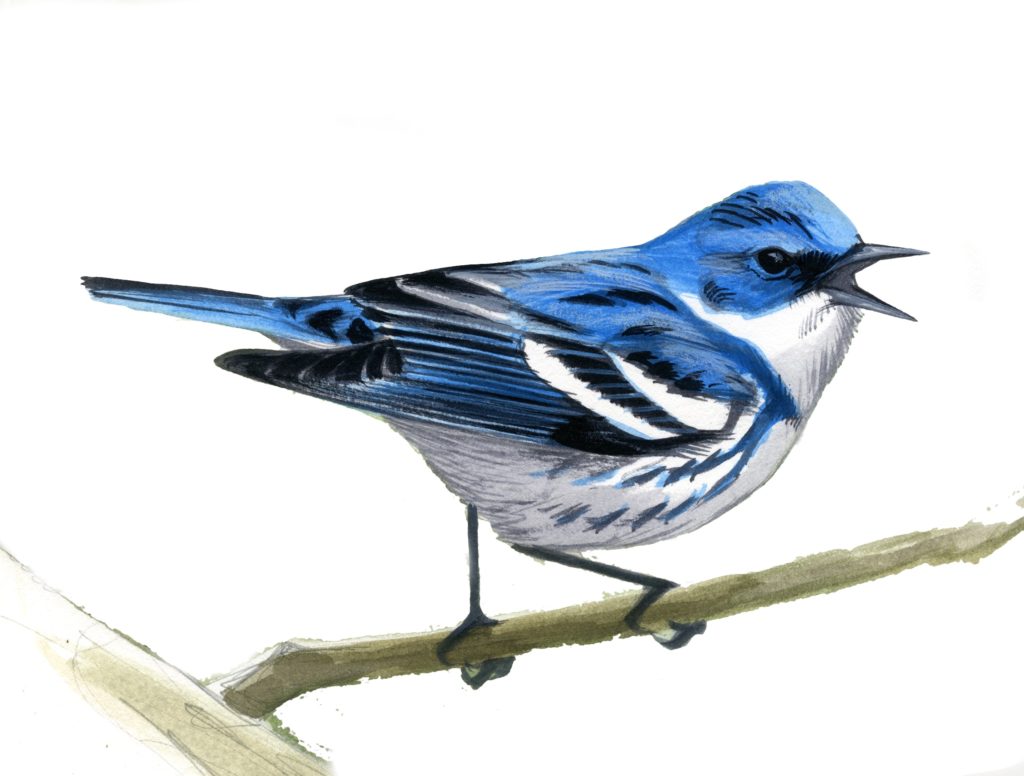
zeerrdl zeerrdl zrrid-zrrid-zrrid-zrrid-zrreeee
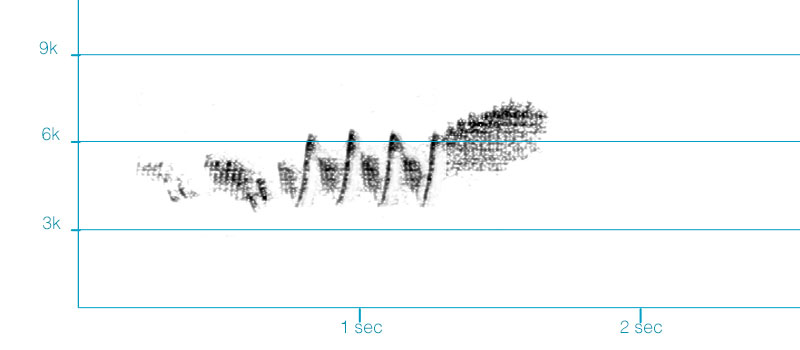
- introductory phrases coarse, buzzy, strongly downslurred, shorter and more complex: zeerrdl
- middle phrases more complex with coarse buzzy elements: zeerre-zeerre-zeerre
- final buzz coarser
Black-throated Blue Warbler
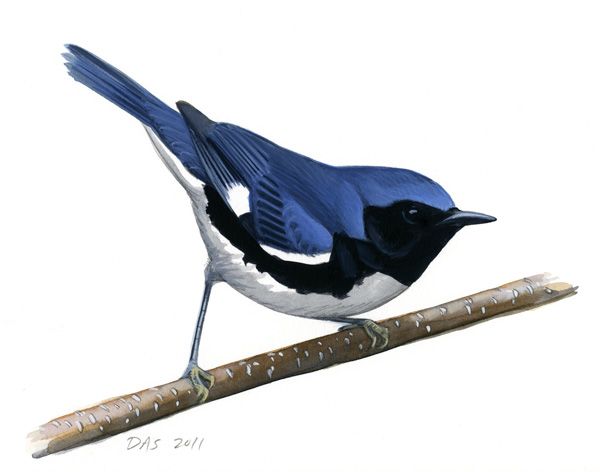
seeooo seeooo zeed-zeed-zeed-zeed-zeeeeee
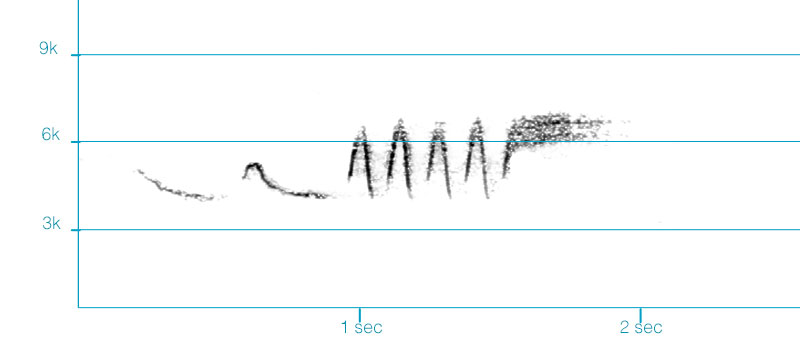
- introductory phrases clearer, less buzzy, less downslurred, longer and simpler: seeooo
- middle phrases simpler, clearer, finely buzzy: zeed-zeed-zeed
- final buzz very fine
The single best way to distinguish these two songs is by details of the introductory phrases. In Cerulean Warbler the first two phrases are buzzy and complex – each phrase comprised of multiple elements. In Black-throated Blue Warbler the first two phrases are closer to whistled in quality, not buzzy, and are simpler – just a single slurred note.
Distribution of the Cerulean-like song variant
This variant of Black-throated Blue Warbler song is commonly heard from territorial birds in southern New England, from northern Connecticut north to central Vermont and New Hampshire, and parts of southwestern Maine. Reviewing recordings in the online collections at Xeno Canto and the Macauley Library, I’ve created a rough outline of the area (below). There are also recordings of this song type well south of there, presumably from migrants headed for New England (e.g. one in Pennsylvania in mid-May https://ebird.org/checklist/S29710626 ).
This map is based on a relatively small number of records, and will undoubtedly be refined as more information comes in. It is unknown what percentage of birds within this region use the Cerulean-like song variant. Any observations of Black-throated Blue Warbler songs in and around the area will be helpful.
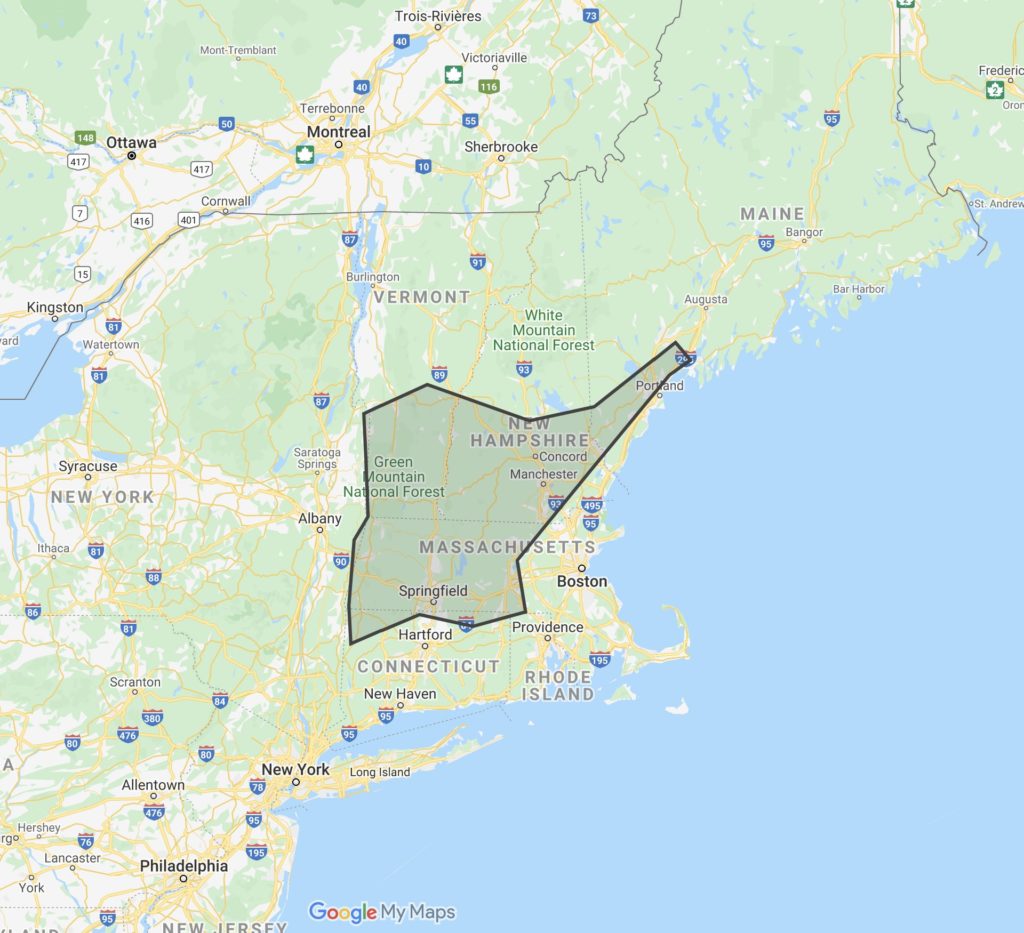
Song categories in warblers
The Cerulean-like variant of Black-throated Blue Warbler is presumably a first-category song. In this species each individual male typically has only one first-category song in its repertoire, and one to six second-category songs.
Males of most wood warblers sing two different song types in different contexts. These have been confusingly named in different studies over the years. Here I will follow the terminology used by Pieplow 2017:
- First-category songs – used mainly in less confrontational settings in the presence of a mate or by unpaired males trying to attract a mate, these songs predominate early in the breeding season
- Second-category songs – used in more confrontational settings such as territorial disputes with neighboring males, given throughout the nesting season
In Cerulean Warbler each male has a repertoire of two or three slightly different songs, and uses one song in first-category contexts and the other one or two in second-category contexts. But there is no difference between first- and second-category songs other than their usage by an individual male.
In Black-throated Blue Warbler the two categories are distinct. First-category songs are a fairly rapid series of less buzzy phrases. Second-category songs are always buzzy, with the harsh, drawling quality characteristic of this species, e.g. zheew zheew zhreee.
In northern Vermont, Hof (2014) found that the slower, buzzy second-category songs outnumber faster, clearer first-category songs by two to four times. Where I hear them, however, in Deerfield, MA, the Cerulean-like variant (first-category) seems to be the most common song throughout the summer. It’s possible that at the lower densities here there are fewer territorial disputes, and birds sing mainly for their mates using first-category songs. The slower, harsher second-category songs should be expected throughout the species’ range. In mapping the distribution and frequency of this song variant it will be important to distinguish between each bird’s first- and second-category songs, and perhaps to take into account other factors that can influence the frequency of first-category singing.


It is amazing how close they can sound around here. People from out of the area are always surprised how similar the two species can sound and I’m always a bit suspect of heard only Cerulean Warbler away from known breeding spots here in Massachusetts. I have tracked down birds I thought for sure would be Cerulean Warblers only to find a Black throated Blue Warbler.
Hi Larry, Thanks for your comment. I’m hoping to bring some attention to this ID pitfall with this blog post. I didn’t appreciate how tricky it was until I moved to the region a couple of years ago. Now I’m also suspicious of “heard-only” reports of Cerulean Warbler away from known breeding locations, and in reviewing audio recordings I found a few claimed Cerulean Warblers that sounded like Black-throated Blue Warbler.
It is a common issue here and one I deal with fairly often in reviewing eBird records. Thanks for the post…no doubt it will shed some light on this ID pitfall.
David,
Thank you very much for this very timely article. We met one of these warblers in the Montreal area three days ago. We had not seen the warbler but despite appearances, we were not at all certain it was a Cerulean. The song was kind of “imperfect” 😉 We were very perplexed and, when we came back home, I made a research to see if I could find some documentation. Then I found your article !
You can listen at the recording in that eBird report :
https://ebird.org/checklist/S69086584
Hi David,
This is a great resource, as I was just trying to explain this phenomenon to someone. It is a very interesting situation, and well described by you here. Can’t wait to send it around.
Alan
Yes!!! Thanks David. I’ve surveyed CERW across southern Ontario. One June morning in an ideal mature hardwood lot I spent close to an hour trying to get a visual on a warbler singing a seemingly perfect CERW song from the dense tree canopy. I set out the bluetooth speaker under a leatherwood shrub and played back the NY CERW song off the Sibley app. Within a minute the singer, a BTBW(!), descended down to the shrub (still singing a CERW song). As an eBird reviewer, I’m more wary of h/o CERW reports. Now, do you suppose some of the recorded reference songs for CERW archived in Macaulay and Xeno-canto are actually misidentified BTBW?
Here’s one from the southern Blue Ridge in Tennessee (where they are resident) in May. https://macaulaylibrary.org/asset/40278821#_ga=2.189950251.1229414410.1593026626-581238723.1590236651
Hi David. I thought I had warbler 29.5 for the season (I have had one of the hybrids), but I wasn’t quite sure of the song, so did some research and came across your article. Good to know for future reference – there was something that wasn’t quite right about the song.
Anyway, it might be helpful to add a thought on whether both these birds sing from the canopy or if there is any clue to be gained by their locations when singing?
I’ve been recording what I took to be CERWs this spring after hearing them in my Fairlee, Vt. mountain forest for several years. At the suggestion of friends at Vermont Center for Ecostudies, who believe they are more likely the BTBW variant, I will send them to the Vermont Bird Records Committee for definite identification. If these would help expand your BTBW variant map and you would like copies, let me know.
So interesting. Thank you, Mr. Sibley. I didn’t realize that this is a regular occurrence as well as a regional one. I heard a Black-throated Blue Warbler in June in Connecticut several years ago that was giving a Cerulean-like song. I was very surprised. I was also relieved that I made the effort to see the singer and obtain a correct ID. This location was farther south than shown on Sibley’s map in this post. Incidentally, in DC a few years ago I had a Yellow-throated Warbler sing a Common Yellowthroat song.
Pingback: What Does A Warbler Sound? – Ploverbirds.com